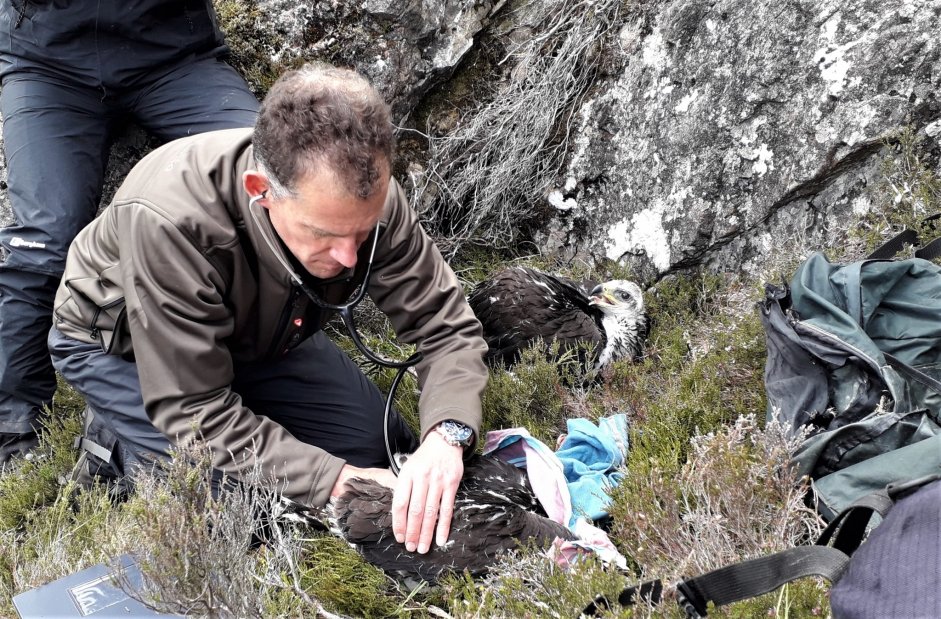Project
BLOG
Restoring
Upland Nature
home to the south of scotland
golden eagle project
Project
BLOG
Dr Neil Anderson is a wildlife vet and lecturer in conservation medicine and one health at the Royal (Dick) School of Veterinary Studies, University of Edinburgh
He also forms part of the Eaglet Collection Team to assess the health of both chicks during potential translocations.
A Huge Thank You to Neil for contributing to our Lockdown Daily Blogs and for all the work he does for the project.
How did you start out as a wildlife vet and what made you want to follow that career?
After graduating as a vet, I spent many years in private practice. Most of this was farm animal work and I really enjoyed the clinical aspects and interactions with my clients. However, I have always had a passion for wildlife and conservation. As I became increasingly aware of the decline in nature, I decided to focus my career on wildlife conservation rather than domestic species. I spent several years doing a PhD in the Luangwa Valley in Zambia, an amazing natural landscape with abundant wildlife. This changed my outlook completely and confirmed that I had made a good decision. It was not easy to get established as a wildlife vet, but my current position at the Royal (Dick) School of Veterinary Studies (RDSVS) provides me with a diverse role including teaching, research and working on conservation projects.
What role do you play in the SSGEP?
I have two roles within the SSGEP. Firstly, I am the chair of the scientific advisory panel. The remit of the panel is to provide expert scientific, veterinary and technical advice to the SSGEP team. This helps the project team to maximise golden eagle health and welfare in all their activities, and ensures that decisions are made based on scientific evidence and best practice. Advice may also be required on wider scientific and land management issues. My role as chair is to help lead this panel and liaise with the project team, facilitate meetings and consolidate advice on relevant issues.
My second role within the project is as a clinical vet. Along with my colleague, Gidona Goodman, I help with the veterinary aspects of the project. Whenever chicks are translocated, we conduct clinical examinations to select the fittest chicks and ensure that there are no under-lying health problems. We also accompany the chicks throughout the translocation and collect blood samples as part of a thorough health assessment. Prior to their release, we re-examine the young eagles to ensure they are healthy enough to care for themselves after their release.
What made you want to be involved with the project?
I think it is a fantastic initiative to re-inforce the population of golden eagles in the south of Scotland. I have lived in the Borders for over a decade now and believe it will be a huge asset for the region to have a healthy population of golden eagles once again. The project has good support from landowners in the region and I think it is a great example of a positive conservation story. I particularly like the project’s focus on schools and local communities, something which is not always prioritised sufficiently within conservation projects. I also relished the opportunity to get out of my office and into some of Scotland’s most pristine and spectacular environments!
Why is it important to you to help the Golden Eagle population in South of Scotland?
Eagles are amazing birds that can contribute a great deal to improving the health of ecosystems and supporting biodiversity. They are an iconic ‘flagship’ species that will attract visitors to the region and indirectly support the conservation of many other species. Having a sustainable population in the south of Scotland will significantly expand the range of golden eagles in the UK. Populations of endangered species are always more vulnerable if they are isolated and restricted to small areas, so expanding the range to areas that have historically supported eagle populations is important. Studies suggest that there is sufficient suitable habitat available to support many golden eagle territories in the south of Scotland, but re-colonisation is unlikely to occur naturally due to the urban development in central belt of Scotland. Translocations of chicks should enable a self-sustaining population to become established.
Pictures:
Top - Dr Neil Anderson
Middle - Neil examines an Eaglet during collection.
Bottom - Neil's role takes him into the heart of Eagle Country.
Do you have a favourite Golden Eagle story or memory?
That is a difficult question as I have many good memories of golden eagles from the project! Golden eagles live in some of the most remote and dramatic landscapes in Scotland which are always inspiring to visit. I remember one occasion in the Cairngorms preparing for a translocation. It was one of the hottest days of the year and there was not a cloud in the sky. The person ringing the chicks assured us that the nest was easy to access and more of a scramble than a climb. As we got higher up the mountain and the gradient became steeper and steeper he disappeared like a mountain goat over the horizon. I was left clinging to the heather admiring the view until we made contact again. I was quite happy being stranded on the mountainside with a view like that and could happily have stayed there all day. The trip was a great success in the end as we successfully translocated a healthy young chick which is now thriving in the south of Scotland.

